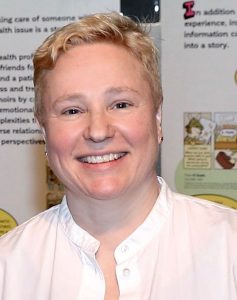During the spring 2020 semester, the Burton Blatt Institute’s (BBI) Office of Interdisciplinary Programs and Outreach (OIPO) hosted its second two-part symposium on the subject of ‘Cripping’ Graphic Medicine. This two-part symposium continued the academic and public engagement events begun during the fall 2019 symposium events from the same series.

MK Czerwiec, R.N., M.A. gave a public lecture, “Graphic Medicine: Can Comics Improve Our Health?” on January 23, 2020, during which she discussed “how comics can help improve our health by making health education more engaging, by amplifying the perspectives of patients and families, as a tool for conducting and translating our research, and as a means by which we can explore our experiences with health, illness, disability, and caregiving,” as noted in marketing and communications materials. Czerwiec hosted a workshop on January 24, 2020, entitled, “Cultivating Care: A Graphic Medicine Workshop.” As explained in the workshop description (now adapted to describe the concluded event), “In this engaged ‘hands-on‘ workshop, participants [had] the opportunity to participate in graphic medicine exercises led by MK Czerwiec, a leader in the graphic medicine field. The workshop [gave] students, faculty, staff, and community members new ways to explore experiences of health, disability, illness, healthcare, and health science education.”
All four programs in the “Cripping” Graphic Medicine 2019-2020 series had the subtitle or tagline—also, a pun—“Drawing Out the Public Sphere.” As noted in the January 10, 2020 Syracuse University News story by Robert Conrad, “Czerwiec has been making comics under the pseudonym Comic Nurse since 2000. With UK physician Ian Williams, she co-runs GraphicMedicine.org, a website devoted to the intersection of comics and health. Her first graphic memoir, Taking Turns: Stories from HIV/AIDS Care Unit 371 (Penn State University Press, 2017), is believed to be the first graphic memoir created by a nurse. She is also a co-author of the Eisner Award-nominated Graphic Medicine Manifesto (Penn State University Press, 2015) which maps the field of Graphic Medicine.“
Both events with Czerwiec took place at SUNY Upstate Medical University. As was the case with the fall 2019 programs, with Prof. Elizabeth J. Donaldson, the spring 2020 programs were funded as facets of the Humanities Center’s Syracuse Symposium series, the 2019-2020 theme of which was “Silence.” All four events were co-sponsored by the Consortium for Culture and Medicine—a collaboration between Le Moyne College, Syracuse University, and SUNY Upstate Medical University—and the Syracuse University College of Arts and Sciences. Research Professor Diane R. Wiener, OIPO’s Associate Director, authored the awarded symposium proposal with Prof. Rebecca E. Garden of Upstate Medical University. Prof. Garden, who is Executive Director of the Consortium for Culture and Medicine, planned all four events with Prof. Wiener, with ongoing support from OIPO’s Administrative Assistant, Rachael Zubal-Ruggieri.
OIPO’s 2019-2020 symposium focused on the emerging cross-disciplinary field of Graphic Medicine. In order to engage Syracuse University’s and Upstate Medical University’s constituents collaboratively, Graphic Medicine draws linkages across disability studies and the health humanities. All events and activities were designed to advance healthcare theory and practice as well as disability justice. More details about the series as a whole and the concept of “cripping” can be found in the fall 2019 OIPO blog posting about these events.
American Sign Language (ASL) interpretation, Communication Access Real-time Translation (CART), image descriptions of visual elements, videography, and inclusive food were all facets of these events. Captioned video recordings of both the fall 2019 and spring 2020 ‘Cripping’ Graphic Medicine public lectures are linked on the OIPO website, with image descriptions provided by the presenters (recorded during their public talks).
Czerwiec’s public presentation was attended by a wide array of faculty members, undergraduate and graduate students, administrators, and local and regional community practitioners from many backgrounds and fields of interest, including disability studies, art history, peer advocacy, digital humanities, journalism, healthcare, and social work. Importantly, a wide variety of students was in attendance, including individuals in medical school, those who are aspiring to be accepted to medical school and other professional healthcare educational institutions, and undergraduates involved in journalism, disability studies, and many other subjects.
The workshop was attended by the all of the above mentioned constituents, as well as community librarians, staff from the Syracuse University Office of Disability Services (now, the Center for Disability Resources), and local veterans. The interactions during both the public presentation and workshop were meaningful and engaging. During the “hands-on” workshop, digital modes of artistic and creative expression—in the forms of iPads and styluses—were provided simultaneously with paper and “hand-held” art supply options, underscoring themes of and commitments to “cripping,” inclusion, and accessibility. Moreover, while Czerwiec visited Syracuse, Prof. Garden and Ms. Zubal-Ruggieri accompanied her to meet a local librarian zine expert, who hosts a zine space where she works at the library; this talented and committed individual subsequently participated in the workshop, and myriad other connections and collaborations unfolded.
Connected vividly with the aforementioned work, Garden, Zubal-Ruggieri, and Wiener presented a paper-in-progress on April 7, 2020, entitled, “Cripping Graphic Medicine: Academic Disability and Health/Care Activism,” during the 2020 Multiple Perspectives Virtual Conference hosted by The Ohio State University. The conference was made 100% digital, in the wake of the COVID-19 pandemic, and including live captioning and ASL interpretation. The co-authors demonstrated their commitment to principles of “cripping” graphic health/care while delivering their content by offering multi-media, digital examples that were image described, and by providing participants with interdisciplinary, accessible resources. Garden, Zubal-Ruggieri and Wiener are currently expanding and editing the paper for publication. The conference abstract read, “This paper proposes theory and practice for a Cripped Graphic Health/Care by describing a ‘Cripping Graphic Medicine Series.’ This Series works across the campuses and disciplines of arts and sciences and health sciences institutions to develop more inclusive and just practices in the emerging field of Graphic Medicine.”